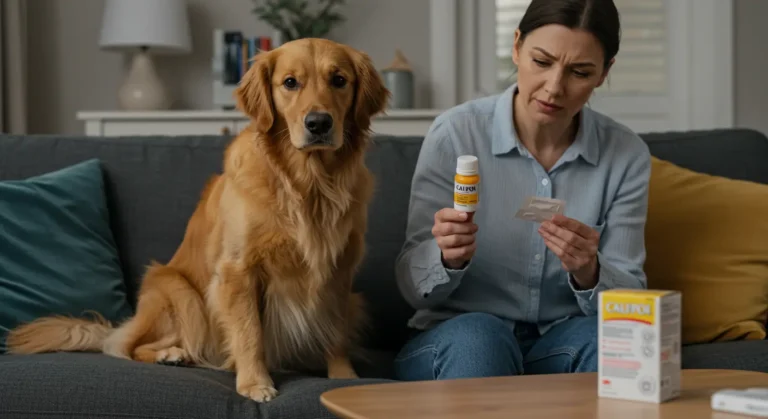Introduction
Many UK dog owners find themselves asking: Can you give dogs Calpol? Maybe your pup is limping or looking uncomfortable, and you are tempted to reach for the same bottle you use for your child’s fever.
But wait—what helps humans can seriously harm dogs. Giving Calpol (paracetamol) to dogs without veterinary supervision can be dangerous—even fatal.
Let’s break it down in clear terms so you can protect your furry best friend.
What Is Calpol?
Calpol is a liquid paracetamol (also known as acetaminophen) commonly used in the UK to treat pain and fever in children.
Ingredients in Calpol:
- Paracetamol (120mg/5ml)
- Sometimes added sugars, colorings, or flavorings like strawberry—harmless for kids, but risky for pets.
Is Calpol Safe for Dogs?
Short answer? NO.
Dogs process medication differently from humans. Even small doses of paracetamol can lead to:
- Liver failure
- Internal bleeding
- Difficulty breathing
- Vomiting or lethargy
⚠️ Especially dangerous for:
- Small breeds
- Puppies
- Dogs with existing liver conditions
Even vets only prescribe very specific doses of paracetamol—and usually as veterinary-formulated meds, not human Calpol.
What Vets Say About Giving Dogs Human Medicine
UK vets and the British Veterinary Association (BVA) clearly state:
“Never give dogs human medication unless specifically prescribed by a vet.”
Why? Because even mild over-the-counter meds like Calpol can lead to life-threatening conditions in pets.
Signs Your Dog Might Be in Pain
Instead of guessing and risking it with Calpol, learn how to spot discomfort in dogs:
- Limping or avoiding movement
- Whining or yelping
- Restlessness or hiding
- Refusal to eat
- Panting or shaking
If you see these signs, don’t guess—call your vet.
Safe Alternatives to Calpol for Dogs
✅ Vet-Approved Options:
- Metacam (meloxicam): Common pain reliever prescribed by UK vets
- Rimadyl (carprofen): Anti-inflammatory used for arthritis or post-surgery
- Gabapentin: Nerve pain relief in chronic conditions
These are prescribed based on your dog’s weight, age, breed, and health history.
❌ Never Use:
- Calpol
- Ibuprofen
- Aspirin
- Naproxen
All of these are potentially toxic to dogs.
Emergency Situations: What If My Dog Already Took Calpol?
First, stay calm. Then:
- Call your vet immediately.
- If after hours, contact a 24/7 emergency vet line (e.g., Vets Now UK).
- Provide details:
- How much Calpol was ingested
- Time of ingestion
- Your dog’s weight and age
Symptoms to Watch For:
- Drooling
- Brown gums
- Difficulty breathing
- Swollen face or paws
- Vomiting blood
FAQs
Q1: Can I give dogs a tiny amount of Calpol in emergencies?
No. Even small amounts without vet approval can be fatal.
Q2: What if I gave Calpol before and nothing happened?
You got lucky. But damage can build up or be delayed. Do not repeat it.
Q3: Is there a dog version of Calpol?
No. While some paracetamol-based meds are prescribed for dogs, they are not the same as Calpol.
Q4: What about baby paracetamol?
Still no. It may contain xylitol (toxic), colorants, or sugar alcohols that are unsafe.
Q5: Can I give Calpol to dogs with a vet’s permission?
Only if the vet prescribes the dose and duration. Never DIY.
Read More : How to Become a Vet Nurse in the UK: A Step-by-Step Guide
Conclusion
So, can you give dogs Calpol? The clear answer is NO, unless your vet specifically instructs you to. Even then, it is not the version meant for human use. The risks far outweigh any temporary relief it might give.
Your pup deserves real care, not risky guesswork. Always talk to your vet, and keep those human meds out of reach!
In summary, while your intentions may come from a place of love, giving dogs Calpol is never a safe option unless explicitly prescribed by a vet. What works for humans can be toxic—even deadly—for dogs. UK pet owners must resist the urge to self-medicate their pets and instead seek professional veterinary advice. Your dog relies on you for care, comfort, and safety, and taking chances with human medicine is simply not worth the risk. Always keep medications out of reach, stay informed, and choose approved alternatives. When in doubt, remember: call your vet, not your instincts.

